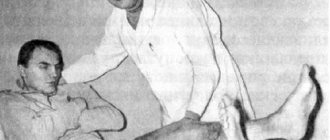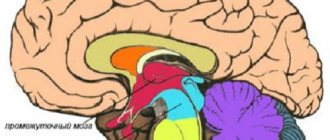With a neuroma of the lumbar spinal cord, the described symptoms will be in the lumbar region and legs. Possible gait disturbances, numbness in the legs, and trophic disorders.
Autonomic symptoms are determined by the location of the neuroma and are reduced to:
- Disorders of the pelvic organs;
- Shortness of breath, sometimes difficulty swallowing;
- Increased blood pressure;
- Disruption of the gastrointestinal tract;
- Arrhythmias.
Damage to the diameter of the spinal cord is accompanied by paralysis, a sharp decrease in all types of sensitivity and trophic changes. This condition is quite dangerous, especially with cervical and thoracic tumor localization, when disturbances in the functioning of the heart or lungs can become fatal.
intermetatarsal neuroma (Morton's neuroma)
Peripheral neuromas
Neuroma of peripheral nerves grows very slowly and is most often located superficially. Usually this is a single small tumor of a round shape, growing along the nerve fiber. Peripheral nerve neuroma manifests itself as intense pain and decreased sensitivity. The progression of the tumor causes paresis of muscle tissue.
If the presence of a neuroma is suspected, the patient is referred to a neurologist, who evaluates the function of the cranial nerves, spinal cord and brain, reflexes, etc. If the vestibulocochlear nerve is affected, an audiogram and consultation with an ENT specialist are prescribed. For neoplasms of the spinal cord and brain, there is a need to prescribe CT and MRI.
Definition of neuroma
In the human body, literally every organ and system is permeated with nerve fibers, and therefore neuroma can occur in any area - from the cranial nerves to the toes. Various provoking factors can cause a failure in the division of Schwann cells - from an excessively high dose of ionizing radiation to chronic tissue injury.
It is not always possible to visually notice a neoplasm at the initial stage of its occurrence. Only as the tumor focus grows and the surrounding structures are compressed does a person notice that damage to the nervous system has occurred in his body.
Among all neoplasias, cerebral forms account for 8–10% of cases, while peripheral nerve neuromas account for 50–65%. Benign space-occupying formations slowly progress and extremely rarely transform into a focus of atypia with metastasis.
Macroscopically, they can be represented as dense nodes with clear boundaries, which are enclosed in a smooth capsule.
If the underlying nerve fibers are not involved in the process, then doctors are able to excise the tumor defect without serious consequences. Otherwise, they resort to other methods of treating the tumor, for example, radiation therapy, gamma knife.
Locations
Benign lesions of Schwann cells with the formation of a focus of metaplasia are characterized by great diversity in localization. Thus, Morton's neuroma has been well studied - it occurs mainly between the third and fourth toes, but cases of a tumor of the nerve between the third and second toes have been described. As a rule, the disease is unilateral.
Schwannoma of the spinal column occurs - mainly in the thoracic region, sometimes in the cervical vertebrae. Thickening of the nerve sheath occurs in the area of the roots. Such formations can even grow through the intervertebral foramina, which entails bone deformations, severe complications, including paralysis.
A special subgroup of neuromas are lesions on the cranial nerves. Already at the initial stage of their development, they are capable of provoking functional failures - for example, damage to the auditory fiber leads to a deterioration in the quality of sound perception, and schwannoma of the vagus nerve becomes the root cause of breathing and digestion disorders. In the retroperitoneal cavity, similar tumor formations also form and require careful differential diagnosis to select the best treatment tactics.
Types of neuromas and code in ICD 10
The International Classification of Diseases is a universal guide to internal diseases of the human body, in which, thanks to coding, doctors from different countries can immediately understand which system is affected. For neoplasms of the myelin sheath of nerve fibers, the ICD-10 code is D 36.1.
Symptoms
Spinal schwannoma, as it grows and increases pressure on the nerve endings, can provoke the following symptoms:
- pain in the back, lower back or neck;
- numbness of the limbs;
- immobilization (partial or complete);
- disruption of the pelvic organs;
- problems with urination;
- increased blood pressure;
- muscle weakness;
- sensory disturbance;
- problems with urinary control.
When the anterior nerves are affected, paralysis and paresis appear, and with tumors of the posterior nerves, sensitivity is impaired with the occurrence of pins and needles and numbness.
As the size of the tumor increases, the symptoms worsen: if previously pain attacks were intermittent, over time pain attacks appear more often and last a long time.
Causes
Doctors could not present scientifically proven and laboratory-tested theories about the causes of the development of the disease in people. Several main versions have been put forward. Thus, the prevailing opinion is that neuroma is a genetically determined pathology. Over generations of the same family, different people developed one or another type of schwannoma.
The version is confirmed by the fact that the 22nd chromosome was discovered in the DNA chain, the task of which is to contain tumor growth. If there is a mutation in this particular link, the mechanism for resisting atypia will be disrupted - Schwann cells are able to divide chaotically.
Provoking factors may be:
- frequent or high doses of ionizing radiation, for example, radiation therapy for tumors of other locations;
- living in an extremely unfavorable environmental environment;
- constant exposure to carcinogens;
- uncorrected nutrition – low percentage of fresh vegetables and fruits in dishes;
- labor activity in enterprises with toxic substances;
- family predisposition to neurofibromatosis;
- chronic inflammatory processes in internal organs and systems.
If it is not possible to reliably identify a relationship with certain external/internal factors, specialists will select treatment for neuroma taking into account general clinical recommendations.
Signs of various neuromas
At the beginning of their occurrence, schwannomas do not bother people in any way - the progression of a benign lesion occurs slowly, without a significant deterioration in well-being. However, the tumor process gradually compresses neighboring cells, provoking their ischemia and necrosis. Therefore, the symptoms of neuroma directly depend on the location of the affected area.
Intervention in the activity of the facial nerve entails disruptions in its innervation of facial tissues - asymmetry of features, numbness, paresthesia.
Acoustic neuroma is a significant decrease in hearing acuity, constant noise in one part of the head. When vestibular structures are involved in the process, unsteadiness of gait, failures in coordination of movements, and unclear orientation in space will be observed.
Schwannomas of the spinal roots are characterized by longitudinal damage to organs - in those areas for which the vertebra is responsible. In advanced forms, muscle paralysis is possible. Pulmonary neuroma has an atypical course - when it is located extrabronchially, people complain of frequent unproductive cough and increasing shortness of breath. If a lesion occurs intrabronchially, then the symptoms are secondary inflammatory in nature - with obstruction of the bronchi and sputum production.
Cervical neuroma has the most varied symptoms - from severe pain to paresis of the muscle tissue of the tongue and larynx. Only a highly qualified specialist can understand the situation and make the correct diagnosis.
Classification
The main gradation of spinal schwannomas is classification according to the location of the tumor:
- cervical spine;
- thoracic region;
- lumbar region.
The most common neuroma is the cervical spine, which is located outside the spinal cord, surrounding it and causing severe compression, resulting in the development of a distinct pain syndrome, partial numbness, and loss of sensitivity.
The tumor happens:
- benign;
- malignant.
In most cases, the pathology is benign in nature: the tumor grows quite slowly, and signs of the disease do not appear immediately.
Diagnosis of neuroma
In addition to a thorough collection of complaints and anamnesis - when a person noted a deterioration in health, what preceded this, what accompanied the formation of a tumor focus - a neurologist or oncologist will definitely prescribe a number of laboratory and hardware procedures, namely:
- imaging methods - from ultrasound examination of internal organs to radiography or computed tomography, MRI of the brain, which will clarify the location of the tumor, as well as its size and the degree of impact on neighboring tissues;
- biopsy with cytological examination - taking cells from the lesion for careful examination under a microscope, which allows you to assess the degree of their malignancy and the risk of transformation into cancer;
- various blood tests - general and biochemical, as well as tumor markers - to get a general idea of the patient’s health and immune barriers.
For formations of cranial nerves, cerebral neuroimaging is used, which allows one to evaluate the functioning of the nerve fiber. Audiometry is recommended for people with significant hearing loss. If the nerve trunks of the extremities are affected, sonography will be in demand.
Diagnostics
A full clinical examination, including assessment of clinical symptoms and neurological status, allows us to suspect a number of pathologies that can lead to compression or compression of the spinal cord and its nerve roots. The condition of the spinal column can be studied using an x-ray examination.
Nevertheless, more informative diagnostic methods allow us to identify the cause of compression. These include computed tomography and magnetic resonance imaging. In addition, puncture of the spinal canal makes it possible to identify liquorodynamic symptoms. Since compression of the spinal cord often results in a blockage of the cerebrospinal fluid pathways. Summarizing all of the above, it should be noted that diagnosing spinal neuroma requires the following types of instrumental studies:
- X-ray examination.
- Computed and magnetic resonance imaging.
- Diagnostic lumbar puncture.
Treatment of the disease
As a rule, in the case of a benign tumor lesion of Schwann cells and the absence of negative symptoms, the treatment tactics for the tumor consist of monitoring it - the patient regularly visits the attending physician and undergoes follow-up examinations. If the size of the lesion remains the same, then it is enough to lead a healthy lifestyle with proper nutrition, giving up bad habits and avoiding provoking factors.
When disease progression is detected, more active action is required. Modern surgical techniques can completely remove the focus of overgrown Schwann cells. Nerve fibers are released from tumor defects, which is associated with a high risk of injury. However, microsurgical methods of intervention greatly increase the chances of a favorable outcome.
When a neuroma is localized in a hard-to-reach place - inside intracranial structures, lungs, in the area of the median nerve - it is more advisable to resort to radiosurgery.
Gamma knife or cyberknife have proven themselves to be excellent. They cope with foci of neoplasia up to 2.5–3 cm in diameter. The rehabilitation period is underway. Generally favorable.
If you visit a doctor late or have a severe tumor lesion, symptomatic therapy will be selected to relieve pain and improve the patient’s quality of life.
Prognosis and prevention
The main criteria that doctors take into account when determining the prognosis of a neuroma are the degree of malignancy of its cells and the location of the lesion. The chances of recovery will be high if highly differentiated neoplasias are removed in the early stages of their formation. The five-year survival rate is 80–90%.
In poorly differentiated forms of the disease, even with rapid tumor removal, recurrence of neuromas is possible, and death occurs 3–5 years after the intervention. The worst prognosis for malignant schwannomas, which are associated with neurofibromatosis, is that the mortality rate exceeds 75–85%.
There are no specific measures to prevent such a neoplasm, since the root causes of its formation have not been definitively established. Secondary prevention measures include avoiding injury to organs, proper, fortified nutrition, hardening the body, and avoiding excessive physical/psycho-emotional overload.
Forecast
As a rule, the prognosis is favorable for most patients. If the tumor can be completely removed surgically, recovery occurs. Relapses of the disease (resumption of the tumor process) are extremely rare. According to clinical statistics, neuroma never becomes a malignant neoplasm. Timely removal of the tumor will help avoid the development of severe forms of compression of the nerve roots and spinal cord.
It can be useful:
- Spinal cord diseases: types, symptoms, treatment
- Spina bifida: treatment in children and adults
- Amyotrophic lateral sclerosis (ALS, Charcot's disease)
- Treatment of spinal cord meningioma
- Spinal cord lesions: symptoms and syndromes












